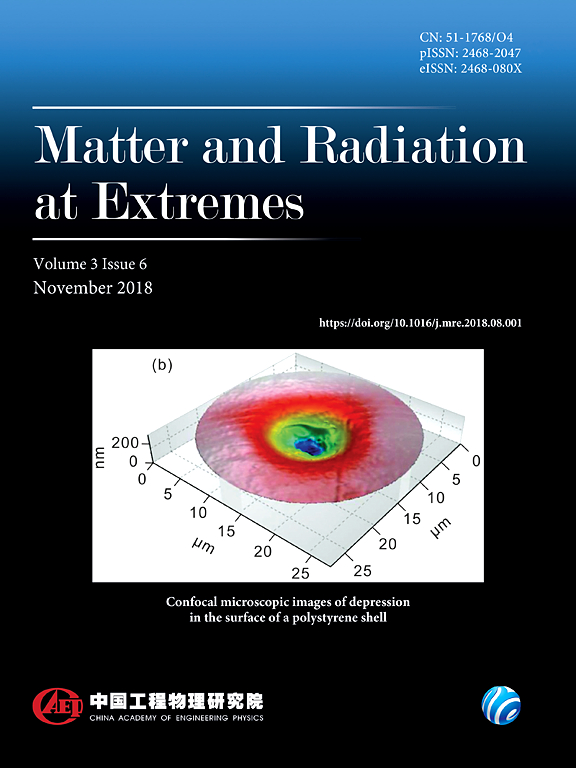Mechanical responses and crystal plasticity model of CoCrNi medium-entropy alloy under ramp wave compression
IF 4.7
1区 物理与天体物理
Q1 PHYSICS, MULTIDISCIPLINARY
引用次数: 0
Abstract
It is of substantial scientific significance and practical value to reveal and understand the multiscale mechanical properties and intrinsic mechanisms of medium-entropy alloys (MEAs) under high strain rates and pressures. In this study, the mechanical responses and deformation mechanisms of an equiatomic CoCrNi MEA are investigated utilizing magnetically driven ramp wave compression (RWC) with a strain rate of 105 s−1. The CoCrNi MEA demonstrates excellent dynamic mechanical responses and yield strength under RWC compared with other advanced materials. Multiscale characterizations reveal that grain refinement and abundant micromechanisms, including dislocation slip, stacking faults, nanotwin network, and Lomer–Cottrell locks, collectively contribute to its excellent performance during RWC. Furthermore, dense deformation twins and shear bands intersect, forming a weave-like microstructure that can disperse deformation and enhance plasticity. On the basis of these observations, we develop a modified crystal plasticity model with coupled dislocation and twinning mechanisms, providing a relatively accurate quantitative description of the multiscale behavior under RWC. The results of simulations indicate that the activation of multilevel microstructures in CoCrNi MEA is primarily attributable to stress inhomogeneities and localized strain during RWC. Our research offers valuable insights into the dynamic mechanical responses of CoCrNi MEA, positioning it as a promising material for use under extreme dynamic conditions.斜波压缩下 CoCrNi 中熵合金的力学响应和晶体塑性模型
揭示和了解中熵合金(MEA)在高应变率和压力下的多尺度机械性能和内在机制具有重要的科学意义和实用价值。在本研究中,利用应变速率为 105 s-1 的磁驱动斜波压缩(RWC)研究了等原子 CoCrNi MEA 的机械响应和变形机制。与其他先进材料相比,钴铬镍 MEA 在 RWC 条件下表现出优异的动态机械响应和屈服强度。多尺度表征显示,晶粒细化和丰富的微观机制(包括位错滑移、堆叠断层、纳米孪晶网络和 Lomer-Cottrell 锁)共同促成了其在 RWC 期间的优异性能。此外,致密的变形孪晶与剪切带相交,形成了可分散变形并增强塑性的编织状微结构。在这些观察结果的基础上,我们建立了一个具有位错和孪晶耦合机制的修正晶体塑性模型,对 RWC 下的多尺度行为进行了相对准确的定量描述。模拟结果表明,CoCrNi MEA 中多级微结构的激活主要归因于 RWC 过程中的应力不均匀性和局部应变。我们的研究为了解钴铬镍 MEA 的动态机械响应提供了宝贵的见解,使其成为一种有望在极端动态条件下使用的材料。
本文章由计算机程序翻译,如有差异,请以英文原文为准。
求助全文
约1分钟内获得全文
求助全文
来源期刊

Matter and Radiation at Extremes
Physics and Astronomy-Atomic and Molecular Physics, and Optics
CiteScore
8.60
自引率
9.80%
发文量
160
审稿时长
15 weeks
期刊介绍:
Matter and Radiation at Extremes (MRE), is committed to the publication of original and impactful research and review papers that address extreme states of matter and radiation, and the associated science and technology that are employed to produce and diagnose these conditions in the laboratory. Drivers, targets and diagnostics are included along with related numerical simulation and computational methods. It aims to provide a peer-reviewed platform for the international physics community and promote worldwide dissemination of the latest and impactful research in related fields.
 求助内容:
求助内容: 应助结果提醒方式:
应助结果提醒方式:


